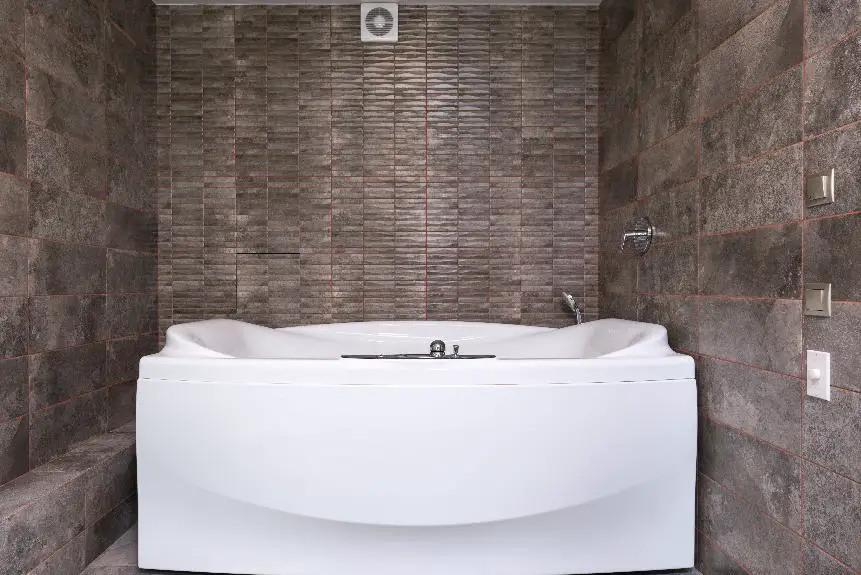Acrylic bathtubs are often chosen for bathroom remodels because they are versatile and affordable. They are lightweight, making them easy to install and have good heat retention, which makes for a comfortable bathing experience. Acrylic is non-porous, so it resists mold and mildew, and is easy to clean. These bathtubs come in many shapes and styles to fit different tastes.
However, there are downsides. Acrylic bathtubs can scratch and show wear over time. They also can be damaged by strong chemicals, so careful cleaning is necessary. Homeowners should consider these pros and cons when deciding on an acrylic bathtub for their renovation.
The Benefits of Acrylic
Acrylic bathtubs have several advantages that make them a popular choice for homeowners. First, they have good thermal insulation, which keeps bathwater warm for longer periods. This feature contributes to a relaxing bathing experience and is valued by those who prioritize comfort. Additionally, acrylic bathtubs are lightweight, making them easy to transport and install. This not only saves on labor costs and installation time but also makes them suitable for renovations or installations in challenging spaces. Furthermore, acrylic bathtubs come in a variety of shapes and sizes, allowing for customization to fit different bathroom designs and user preferences.
Another benefit of acrylic is that it is non-porous, making it resistant to fading and staining. This material also maintains its shine with minimal cleaning. Additionally, acrylic is durable and can be easily repaired if scratched or slightly damaged. This durability ensures that the bathtub will last for a long time, providing homeowners with a reliable and attractive option.
Acrylic Tub Design Options
Acrylic bathtubs offer a wide variety of shapes and styles, suitable for different bathroom layouts and personal preferences. These tubs are available in modern and traditional designs, including options like claw-foot styles. Acrylic is known for its long-lasting appearance, as it resists staining and maintains its shine over time. This durability is important for bathtubs, which are used frequently.
In addition to shape and style, acrylic allows for a range of colors and finishes, making it easy to match the tub with other bathroom elements for a unified look. The material's lightweight quality is beneficial for homes with structural limitations, making installation easier compared to heavier tub materials.
Installation and Maintenance
Installation of acrylic bathtubs is simple due to their lightness, reducing time and cost. They can be placed without extra floor support on any level of a home, offering installation flexibility.
Acrylic tubs are easy to clean because their non-porous surface resists dirt and grime. Regular cleaning with appropriate products is necessary to maintain their appearance and extend their lifespan. Scratches can be repaired to keep the tub looking new.
However, acrylic bathtubs can stain and scratch if not cared for correctly. Harsh chemicals and abrasive cleaners must be avoided to prevent damage. Non-abrasive cleaners designed for acrylic should be used to maintain the tub's glossy finish and prevent soap scum and stains.
Potential Drawbacks
Acrylic bathtubs have their own set of maintenance considerations. They are prone to scratches and damage if cleaned with abrasive tools or strong chemicals. Additionally, they can fade or discolor when exposed to prolonged sunlight or harsh cleaners. To preserve the appearance of an acrylic bathtub, it is recommended to use gentle, non-abrasive cleaning products and keep the tub out of direct sunlight.
Comparatively, acrylic tubs may not retain heat as well as heavier materials like cast iron. This can be a disadvantage for those who prefer longer baths. Additionally, acrylic tubs may feel less solid, which can affect the perception of quality.
However, with proper care such as avoiding direct heat and harsh chemicals, an acrylic bathtub can remain in good condition for a long time. Neglecting proper maintenance can reduce its lifespan. While acrylic is cost-effective and versatile, it may lack the luxurious look of more expensive materials, potentially altering the bathroom's aesthetic.
Longevity and Durability
Acrylic bathtubs offer a good combination of long-lasting use and lightness, making them suitable for both home and commercial settings. They resist chipping, cracking, and fading well, and with proper maintenance, can keep their new appearance for many years. Acrylic is non-porous, which helps prevent stains and makes cleaning easy with gentle cleaners.
Acrylic bathtubs retain heat better than many materials, keeping water warm longer, which contributes to user comfort and may help the bathtub last longer by reducing stress on the material. However, they typically don't last as long as cast iron tubs, which can last nearly a century. Acrylic bathtubs have an average lifespan of up to 15 years, making them a viable option for bathroom installations.
It is important to protect acrylic bathtubs from direct sunlight to prevent discoloration and structural damage. Proper installation away from harsh sunlight is important for maintaining their condition.





